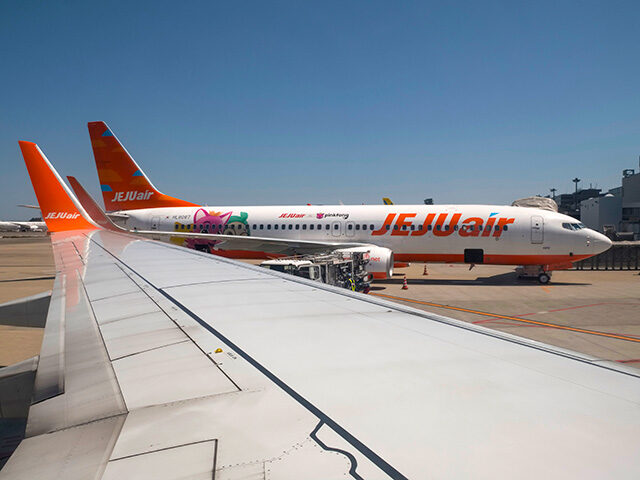One day after a Boeing 737-800 flying for South Korea’s Jeju Air burst into flames during an emergency landing necessitated by landing gear problems, a second Jeju Air airplane of the same type reported a landing gear problem and returned safely to its departure airport.
The first plane, Jeju Air Flight 7C-2216, reported a bird strike on approach to Muan International Airport southwest of Seoul on Sunday morning. For reasons still unclear, the plane was unable to deploy its landing gear, so it attempted a “belly landing” with catastrophic results. The plane slammed into a concrete wall after skidding along the runway, broke apart, and caught fire, killing all but two of the 181 passengers and crew on board.
The second incident on Monday involved an early morning flight departing from Gimpo International Airport on the western edge of Seoul.
Jeju Air Flight 7C-101 reported a landing gear malfunction shortly after takeoff and promptly returned to Gimpo. The Boeing 737-800 landed safely and transferred most of its passengers to another aircraft, causing a total delay of about two hours. According to local media reports, 21 of the passengers declined to board the new jet because they were worried about flight safety.
“Shortly after takeoff, a signal indicating a landing gear issue was detected on the aircraft’s monitoring system,” a Jeju Air representative said on Monday.
Monday’s flight was destined for Jeju Island, South Korea’s largest island and a popular tourist destination, from which the airline derives its name. The island is large enough to have its own international airport, in addition to boasting the world’s largest water park and South Korea’s tallest mountain.
Jeju Airlines operates 41 aircraft, 39 of which are the same Boeing 737-800 model involved in Sunday’s crash and Monday’s landing gear alarm. The South Korean transportation ministry said on Monday it does not believe grounding the Boeing planes is necessary, but all of them will be subjected to urgent and thorough safety inspections.
A technical team from Boeing has been dispatched to South Korea to assist in the safety inspections, along with inspectors from the U.S. National Transportation Safety Board (NTSB) and Federal Aviation Administration (FAA), which became involved because an American-made plane was involved in Sunday’s crash.
Records for the plane that crashed on Sunday indicate it was constructed 15 years ago at Boeing’s factory in Renton, Washington State. The twin-engine jetliner was operated by Ryanair, a discount carrier in Ireland, from 2009 to 2016 before being purchased by Jeju Air in 2017.
The Boeing 737-800 is one of the most popular aircraft in the world, and it has a generally excellent safety record. Roughly 4,400 of the planes are currently in operation around the world, most of them around the same age as Flight 7C-2216’s plane.

COMMENTS
Please let us know if you're having issues with commenting.